Operation: Mailly-le-Camp, Aube, France
Date: May 3/4 1944 (Wednesday/Thursday)
Unit: 625 Squadron
Type: Lancaster I
Serial: ME697
Code: CF-A
Base: RAF Kelstern, Lincolnshire
Location: St. Agnan (Yonne), France
Pilot: Sqn Ldr. Robert William Hyne Gray DFC 134113 RAFVR Age 32 - PoW No. 6945 Camp: Stalag Luft Sagan and Belaria - L3
Fl/Eng: F/O. David Charles Martin 52312 MiD RAF Age 28 - Killed
Nav: F/O. Leslie Frank Medway 143849 RAFVR Age 20 - Killed
Air/Bmr: F/Sgt. Walter Alec Clarence Footman 1391733 RAFVR Age 24 - Killed
W/Op/Air/Gnr: Sgt. Patrick John Evans 1387533 RAFVR Age 23 - Evaded and reached UK safely on 24 June 1944.
Air/Gnr (MU): P/O. John George Johnson J85585 RCAF Age 31 - Killed
Air/Gnr (R): Sgt. Benjamin Escritt 1071465 RAFVR Age 23 - Killed
We appeal to anyone with further information and/or photographs to please contact us via our Helpdesk.
INTRODUCTION
F/O. R.W.H. Gray and crew were posted to 625 Squadron RAF Kelstern, Lincolnshire from 1656 Heavy Conversion Unit at RAF Lindholme in the West Riding of Yorkshire on 11 November 1943.
He found himself on the Battle Order for 18 November 1943 to attack Berlin, as ‘second dickie’ in the crew of Sqn Ldr. J.R. Cantham: Cancelled - unable to get a/c serviceable in time.
In a rather unusual manner, both P/O. Medway and F/O. Gray, were initiated to the realities of operational flying — P/O. Medway as a second navigator in the crew of Fl/Lt. Spiller and F/O. Gray as a second pilot with P/O. Bowden’s crew for the 22 November 1943 Berlin trip.
The Gray crew returned to Berlin on 26 November 1943 with Sgt. R.P.W. Clackett as flight engineer and P/O. Armstrong as bomb aimer: Abortive. Difficulty in gaining height to 17,000 ft. Effort made to go to Stuttgart as an alternate by jettisoning part load, but whole load lost due to faulty manipulation.
After a six week reprieve, F/O. Gray and crew with Sgt. Clackett in the flight engineer’s seat, had an uneventful trip to Brunswick on 14 January 1944, with the exception of GEE being u/s on the homeward journey.
On 20 January 1944 F/O. Gray and crew with Sgt. Clackett and newly promoted F/O. Medway visited Berlin again with an enthusiastic debriefing: 'Target bombed from a height of 20,000 ft. A good concentration of Wanganui flares. Considered to be “a wizard prang”'.
They had two uneventful trips back to the Big City on 27 and 30 January 1944 with Sgt. Clackett as flight engineer.
On 15 February 1944, with a new stripe, Fl/L. Gray and crew with Sgt. P.H. Miller as flight engineer had an uneventful trip to Berlin.
With an unusual crew shuffle, they had a quiet trip to Schweinfurt on 24 February 1944. Spare bods included Sgt. L.V. Huntington, flight engineer, Sgt. H.M. Greene, bomb aimer and Sgt. A.F. Masters in the rear turret.
On 1 March 1944 Fl/L. Gray and crew with Sgt. Beckwith as flight engineer were forced to land at RAF Grimsby after a mission to Stuttgart.
They returned to Stuttgart on 15 March 1944 with F/O. D.C Martin as flight engineer for their remaining ops. W/O. J.P. Cosgrove joined them for his second ‘dickie’ experience. P/O Cosgrove and his crew would perish on 18/19 April 1944, when attacked by a Nachtjagd intruder, returning from Rouen on final approach at Kelstern. This chilling event will be covered in a pending archive report on the loss of ME734.
On 30 March 1944 Fl/L Gray and crew flew ME697 for the first time on an uneventful op to Nuremberg. She would be their mount for the remainder of their missions.
Their next two trips to Aulnoye and Cologne on 10 and 20 April 1944 were quiet. The former with Fl/L. Grays’s regular crew and the latter with F/Sgt. J. Dudman as ‘second dickie’ and his crew, with the exceptions of F/O L.F. Medway, navigator and Sgt. B. Escritt, rear gunner. P/O. Dudman and crew in ND742 would fail to return from the 10/11 June 1944 Achères raid, no survivors.
On 26 April 1944 they broke the jinx of their thirteenth op with an uneventful attack on Essen.
As a newly promoted Squadron Leader, Skipper Gray and crew returned from Lyons on 1 May 1944, unaware that Lady Luck had removed her protective shield for their next op.
The Battle Order for 3 May 1944 detailed Sqn Ldr. Gray and his regular crew to attack the Wehrmacht barracks at Mailly-le-Camp.
THE RAID ON MAILLY-LE-CAMP 3/4 MAY 1944
Jack Currie in his book, Battle Under the Moon - The documented account of Mailly-le-Camp, 1944, provides a vivid description and analysis of this raid. For those interested it is a must read. In addition his publications include: Lancaster Target, Mosquito Victory, Wings over Georgia and The Augsburg Raid. His BBC documentary, The Lancaster Legend, provides evidence of his dry humour and wit and gives a vivid, realistic account of the life of a bomber crew with No. 12 Squadron, RAF Wickenby.
The end of the Battle of Berlin was punctuated by the catastrophic March 30 1944 Nuremberg raid that left Bomber Command licking its wounds. http://www.aircrewremembered.com/nicholls-thomas-m...
The risks of planning a raid in conditions of bright moonlight, without cloud cover, were exemplified with a raid that should have been scrubbed. Was the lesson learned?
Bomber Command was now under the direction of General Dwight Eisenhower, Supreme Commander of the Allied Expeditionary Force (SCHAEF), with orders to weaken German defences in preparation for pending Operation Overlord, the Normandy invasion. With this in mind the intelligence report, at the end of April 1944, provided by two young French Resistance farm workers, of a panzer battalion en route to the French military depot at Mailly-le-Camp, was given high priority for a precision bombing raid. Timing and accuracy were of the essence as the depot was located one mile east of the village. With this in mind, a favourable weather forecast of clear skies, good visibility and a three quarter moon for the evening of May 3/4 1944, provided a tight time schedule to plan a raid that minimized risk to French civilians. To maximize accuracy a lower bombing altitude of 6,000 to 8,000 feet was selected.
As S/L Currie points out there was an element of 'overkill' when an entire bomber group was assigned to bomb a target of nine square miles, with the barracks and repair facilities occupying only a small, concentrated area within the confines. Such a target would normally require four to five bomber squadrons, with a total bomb load of two to three hundred tons of high explosives. This would prove to be significant in the final outcome.
The Plan
The plan for this raid was complex and developed in a matter of days. W/C Leonard Cheshire played a significant role in the process and was to be the officer leading the Mosquito Pathfinders responsible for marking the target. 83 Squadron C.O., W/C Laurence Deane, was to be the Main Force Controller delegated with coordinating bombing of the target and the Deputy Controller was to be Squadron Leader Neville "Ned" Sparks also of 83 Squadron.
The main force consisted of a total of 346 Lancasters, 173 from No.5 Group and 173 from No.1 Group, from a total of twenty squadrons, detailed to attack in two waves. The first wave was to bomb on two aiming points, one marked by W/C Cheshire and his deputy, S/L Dave Shannon, and the second by Lancasters of the Special Duties Flight from Binbrook. It is noteworthy that the latter markers were briefed independently and W/Cs Cheshire and Deane were not aware of their participation in this raid.
After the first wave had bombed, there was to be a nine minute cessation in bombing, in order for the Pathfinder Mosquitos to mark a third aiming point for the second wave to bomb. If for some reason there was a delay in accurate marking, the second wave was to orbit the assembly point above a yellow marker, at bombing altitude in a left hand orbit until called in to bomb by the Main Force Marker.
The Timetable
Timing and coordination were critical for this raid to be successful. W/C Cheshire was delegated with planning the timetable for this raid. In order to maximize casualties, H-hour was chosen as 0001 hours on May 4 1944 to ensure that all off duty soldiers would have returned to their quarters. With this in mind the following schedule was proposed:
4 May 1944
0001 Hrs - W/C Cheshire and S/L Shannon mark the eastern aiming point with red spot fires. At this time the SD Flight would also mark a “special target” with green spot fires, to be bombed by thirty Lancs of the 1 Group main force controlled by the “1 Group MC” — all unbeknownst to W/Cs Cheshire and Deane!*
0007 Hrs. - Main Force Controller calls the first wave of 5 Group Lancasters in to bomb.
0012 Hrs. - The simultaneous attacks on the eastern aiming point and “special target completed.
0021 Hrs. - Cheshire’s second pair of Mosquitos complete the marking of the western aiming point with red spot fires.
0021- 0027 Hrs. - The second wave of one hundred and forty Lancs of 1 Group force are called in and bomb on the aiming point.
In the event of delays, captains were to execute wide left-hand orbits over the assembly-point at altitudes between 8,000- 12,000 ft. until called in to bomb. The assembly-point, located at Germinon, nineteen miles north-north-west of the target was to be continually marked by a yellow spot fire.
*Note: For the first time, a raid was to have three controllers and moreover, one of them non-existent to the other two! Under normal circumstances a Master Bomber or Master of Ceremonies (MC), would oversee the marking of the target, bombing instructions for the main force and request for backup markers if indicated. For the Mailly-le-Camp raid there would be no MC but instead a Marker Leader (W/C Cheshire) and a Main Force Controller (W/C Deane). In addition, and non-existent to the first two, there would be a '1 Group MC' to control the SD Flight Lancs designated to attack the 'special target'.
The Route
The route for this raid was straight forward and under normal circumstances should not have been a problem. However, taking into account other circumstances, this was not to be so. The route was selected by the 5 Group Staff:
Outbound Route: Bases to Reading. Reading to Beachy Head. Beachy Head to just north of Dieppe. Dieppe to assembly-point or “datum-point” near Germinon. Germinon to target at Mailly-le-Camp.
(Base - Reading - Beachy Head - 50°00’N 01°15’E - 48° 54’N 04°05’E (assembly point) – TARGET)
Delay contingency: Germinon, wide left-hand shuttle at altitude of 8,000- 12,000 feet until called in to bomb.
Inbound Route: Mailly-le-Camp, maintain heading ten miles south to Troyes. Troyes, turn westward to Fontainebleau. Fontainebleau climbing turn to 12,000 ft. to point south of Paris. South of Paris turn ten degrees north to Flers. Flers fly due north to cross the coast at Arromanches. Arromanches to Selsey Bill. Selsey Bill to Base.
(TARGET - 48°25’ N 04°15’ E - 48°18’N 02°00’E - 48°35’N 00°30’W - 49°22’N 00°50’W - Selsey Bill – Reading - Base)
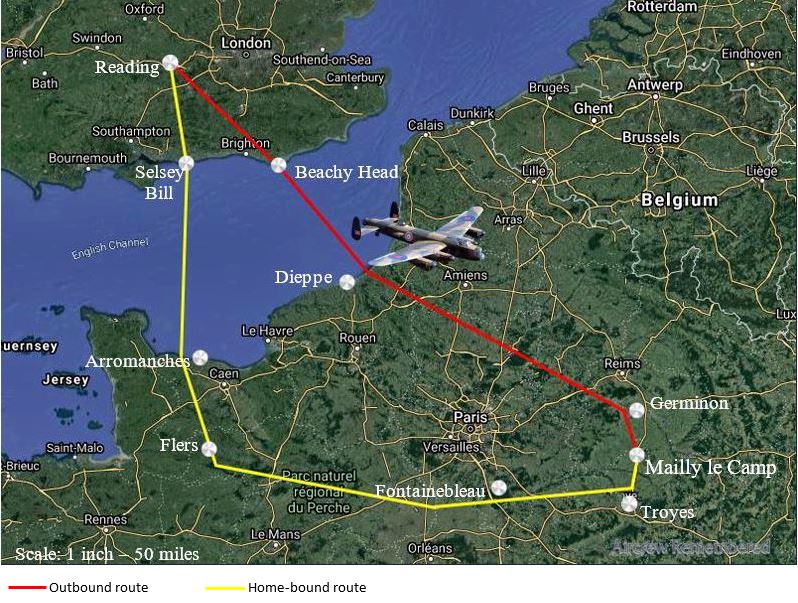
Target Marking
Communications to control and coordinate this complex raid on a relatively small localized target adjacent to a French village would prove to be challenging and problematic as the raid progressed. Three controllers would be overseeing three individual groups in orchestrating a bomber stream of 346 Lancs to bomb their target in 26 minutes. There was absolutely no room for error.
The Pathfinder Mosquitos delegated to mark the east and west aiming points would be transmitting among themselves on VHF and HF with the Main Force Controller. The Main Force Controller would notify the main force of orders by Morse code transmissions on W/T (wireless telegraphy). It appears that the phantom 1 Group MC would be using HF for directing Special Duty Force markers and main force. The Pathfinder Mosquitos did not have W/T capability. If this is confusing to the author, one can only imagine the effect on the aircrews in the heat of battle when the master plan began to unravel. Until the Mailly-le-Camp raid, the edict of strict radio silence for security reasons was adhered to, almost without exception. Open transmissions by bomber captains via R/T (radio telephony) into the ether were unheard of. This was about to change.
The Opposition
Nachtjagd opposition to this raid would be mounted primarily by three night-fighter wings at Athies-sous-Laon, Florennes, Coulommiers and St. Dizier. They could muster a total of sixty serviceable Tame Boar (radar equipped) night-fighters at any one time. In addition there were three day-fighter wings which could provide support with pilots capable of Wild Boar (visual) night-fighting tactics. A veritable hornets' nest taking into account their proximity to the target and assembly-point!
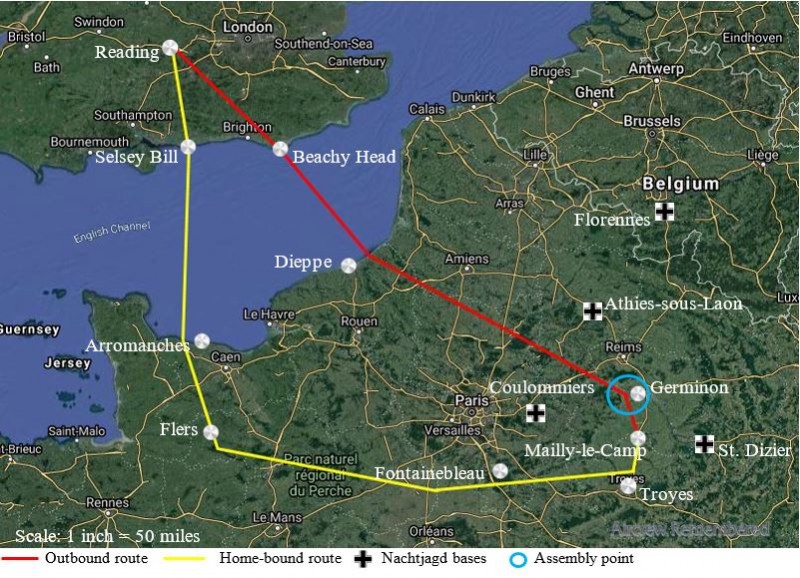
The stage was set for a raid that could be carried out with clockwork precision or come off the rails with the slightest deviation from the norm. Unfortunately, Murphy’s Law would prevail.
The Special Target
The 'special target' to be marked by the SD flight of 1 Group was the base's tank repair facility and the 30 Lancasters that were to carry out this raid within a raid, were to be provided by 460 and 625 Squadrons and as mentioned above, controlled by their own 1 Group MC whilst W/Cs Cheshire and Deane were to remain ignorant of the whole affair.
460 Squadron provided 18 Lancasters for the raid whilst 625 Squadron provided 15, a total of 33 aircraft of which 30 were detailed to attack the special target together with 4 Lancasters of the Special Duties flight which would also mark the target. However, one of the 460 aircraft failed to take off thereby reducing the special target force to 29. Loss cards of two of the 460 Squadron losses (JB741 Baker and ND531 Gritty) and one of the 625 Squadron losses (LM317 Short) indicate that these three were designated to attack in the second wave. This would seem to explain why only 29 were detailed to attack the tank repair facility
The Raid
W/C Laurence Deane, the Main Force Controller, was airborne at 2145 on 3 May from RAF Coningsby, Lincolnshire to set the wheels in motion, whilst at about the same time, some 25 miles or so further north, the crews of 460 and 625 Squadrons were also taking off from RAF Binbrook and RAF Kelstern respectively.
Among the aircraft of 625 Squadron was Lancaster ME697 CF- A 'Apple' captained by Sqn Ldr. Robert William Hyne Gray DFC. Airborne at 2152, ME697 carried a bomb load consisting of 1 x 4000 lb 'Cookie' blast bomb and 16 x 500 lb general purpose bombs. The aircraft was also armed with 6000 rounds of ammunition and was equipped with H2S (The first airborne, ground scanning radar system that identified targets on the ground for night and all-weather bombing. Its capability also provided a long range means of navigation by identifying landmarks) and Fishpond (Worked as an additional part of the H2S system. It was inclined to give false warnings and was withdrawn during 1944 when it was discovered that the Germans had developed a method of homing in on its signals)
At 2204 W/C Cheshire, Marker Leader, departed Woodhall Spa in a Mark VI Mosquito. Rather than arrive early at the target, he elected to patrol the night fighter base at St. Dizier.
3 May 1944
2355 Hrs. - Oblt. Helmut Then claims the first Lancaster, LM417 of 101 Squadron. This would be a portent for the raid’s fate. The Nachtjagd controllers managed to vector the Tame Boar crews into the bomber stream in the last 80 kilometres to the target.
4 May 1944
0001 Hrs.- Assembly-point is marked by a Pathfinder Mosquito and Group 5 Lancs begin their orbit. - W/C Cheshire accurately marks the aiming point and his marking was backed up. Orders were immediately passed to the Main Force Controller to start bombing. However, communications broke down and a critical delay of five minutes occurred before the message was passed on to main force. The transmission was interrupted by a station broadcasting American news and the pop tune, The Yellow Rose of Texas*. In addition, the leader’s transmitter was at least 50 kilocycles off frequency. This delay would prove cataclysmic.
*In his recollections, Sgt. Ron Eeles, the rear gunner of Lancaster ND647 of 49 Squadron, states that '...it appeared impossible to receive any radio instructions due to an American Forces Broadcasting Station blasting away. I remember only too well the tune, “Deep in the heart of Texas”, followed by hand clapping and noise like a party going on' - see http://www.49squadron.co.uk/assets/pdf/ron_eeles.pdf
Debriefings of surviving crews provided a vivid picture of the consequences resulting from this communication breakdown that resulted in arriving aircraft joining the orbit above the clearly marked assembly point, in brilliant moonlight — many for ten to twenty minutes, as Nachtjagd crews mauled them like ducks in a carnival shooting gallery. The vivid accounts and open radio transmissions give one the sense of the apprehension, fear and anger as they witnessed their comrades blown into oblivion. The metallic taste of adrenalin was raw on the palate, the terror palpable.
'Sgt. Frank Broughton, a 97 Squadron WOP on his second op, over the target managed to catch a glimpse of the action. In a matter of minutes he witnessed six massive explosions, the sudden demise of Lancs and their crews. Before returning to his seat he reflected, "By heck, this is a bit rough!" Such accounts went a long way to dispelling the Scarecrow shell myth'.
Open transmissions from exasperated captains provide insight of their emotional turmoil:
'Come on, Master Bomber, pull your finger out!'
'Two of my crew are dead already,' someone shouted, 'for Christ’s sake do something, or we’re all going to die'. Out of the flash-broken darkness came a dusty answer, delivered in a harsh, Australian twang: 'Die like a man then, you yellow bastard. And do it quietly.'
'What the hell’s happening,' asked a plaintive voice, 'where are the markers?'
'If this is a third of an op,' growled another, in a Canadian accent, 'I’m half-way to going LMF.'*
'Shut up.' came a rebuke. 'What are the Jerries going to think of the RAF, hearing all this?'
'F… you, and the RAF- I’m RCAF!'
'I don’t mind dicing,' argued one pilot, 'but this is bloody suicide!'
* Several weeks prior to the Mailly-le-Camp raid, Bomber Command senior staff had introduced the criteria that operations to targets in Occupied Europe would count as only one third of an op, in contrast to a mission into Germany counting as one of the thirty required to complete the first tour. It did not take long for this policy to be reneged after the Mailly-le-Camp raid.
Receiving no word to attack, Ned Sparks, the Main Force Deputy Controller, assumed that Deane had been shot down and took control. He began signalling the force to attack, initially by wireless signal, and then by radio transmission.
It is noteworthy that at this point W/C Cheshire, on witnessing the carnage over the assembly-point, attempted to order everybody back to base as soon as possible.
'In the whole of my operational career I had never seen so many aircraft going down in so short a space of time and I knew that this could only be because most of the available Luftwaffe night fighters were in the sky and with the bright moon our aircraft would have little chance'.
Unfortunately, due to the complexity of the communication frequencies, this order was never received by the aircrews caught up in the heat of this one sided battle.
0010 Hrs. - First wave’s attack on the east aiming point had just begun, when it should have been near completion. The second wave was nearing the assembly-point.
0016 Hrs. - Two-thirds of the first wave had not made their bombing runs.
0023-0025 Hrs. - Bombing did not cease and W/C Cheshire ordered Pathfinder Mosquitos to re-mark the aiming point. The second Mossie encountered a 4000 pound ‘cookie’ blast at 3000 feet and was fortunate to survive, taking three miles to regain control.
0029-0033 Hrs. - Second wave is ordered in to bomb.
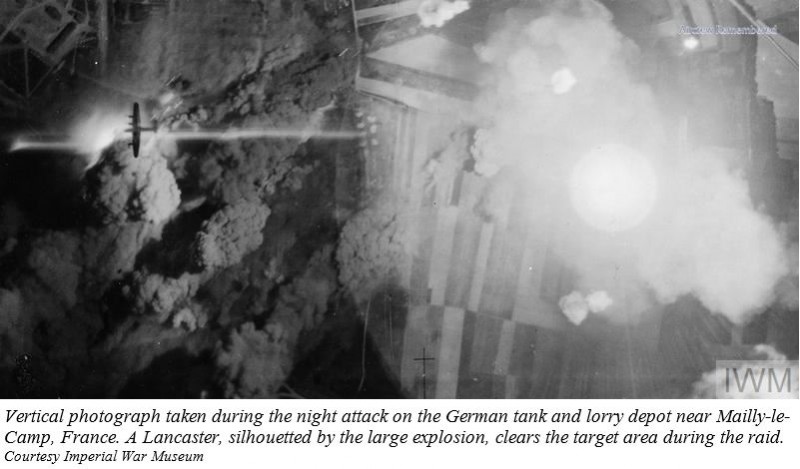
It is not surprising that amid the chaos and confusion the 29 Lancasters of 460 and 625 Squadrons designated to hit the 'special target' enjoyed no better fortune than those attacking the main target.
According to 460 Squadron records, the special target was marked by a green spot fire at about 2359 hours but this was estimated to have undershot by 1000 yards and the next one was laid with an approximate error of 500 yards. Eventually the Deputy MC claimed to have succeeded in placing another marker which fell nearer to the aiming point and crews were then called in to bomb at 0011 hours. By that time, however, the attack on the main target had commenced and in view of the time lag, the MC instructed crews to switch over and bomb the same area as the main force. Once again much interference was caused in the R/T, and several crews not receiving the message continued to bomb on their original target. Very little assessment of results was possible but two station plottings suggest that their bombs were almost on the aiming point.
The No. 1 Group Summary of Operations for the night of 3/4 May 1944 includes the following details relating to the attack on the 'Special Target' :-
Target - Mailly le Camp - Special Aiming Point
Detailed 30 Lancasters plus 4 markers
Took off 29 Lancasters plus 4 markers
Succcess "A" 12 Lancasters plus 3 markers
Abortive NOET 2 Lancasters plus 1 marker
Missing 6 Lancasters
9 aircraft were diverted to the main target
The following observations may be relevant:- The total of 6 missing aircraft is presumably made up of the 3 Lancasters of 460 Squadron, 2 Lancasters of 625 Squadron and Lancaster ND860 of 1 Group Special Duties flight (target markers) which although a 460 Squadron aircraft it was crewed by airmen of 101 Squadron and was not included among the 29 detailed by 460 and 625 Squadrons. Of the 29 only 1 Lancaster i.e. ME744 of 460 Squadron is recorded as having aborted the operation. 3 of the 4 markers are recorded above as having been succesful and ND960 was missing - shot down, yet 1 marker is recorded above as having aborted the operation.
REASON FOR LOSS
Although Lancaster ME697 flown by Sqn Ldr. Gray and crew duly delivered its bomb load, it is not known whether they bombed the main or the special target. However they made good their extrication from the target area unscathed and by 0200 hours were more than half way home when they were attacked by a night fighter(s).
Theo Boiten attributes the following claimant for the loss of ME697:
Uffz. Philipp Feilen: 1 9/NJG4 4-mot 10 km SE Montereau-Fault-Yonne 00.55 625 Sqn. Lancaster
Theo and Rod MacKenzie are in the process of publishing the expanded Nachtjagd Combat Archive (NCA), comprising fifteen volumes, with a projected completion date of late 2021 to early 2022. This includes two additional volumes on the Med and Eastern Front Nachtjagd.
A lifelong mega-project that is eagerly anticipated by historical aviation enthusiasts. The trojan task of expanding the two volume Nachtjagd War Diaries into the fifteen volumes of the Nachtjagd Combat Archives has been monumental and painstaking, their research diligent and unbiased. They have both been most gracious with their time and energy in responding to our numerous queries researching loss causes of numerous 625 Squadron Lancs and their crews.
The Squadron ORB noted the all too familiar: MAILLY-LE-CAMP. Failed to return-no news after take-off.
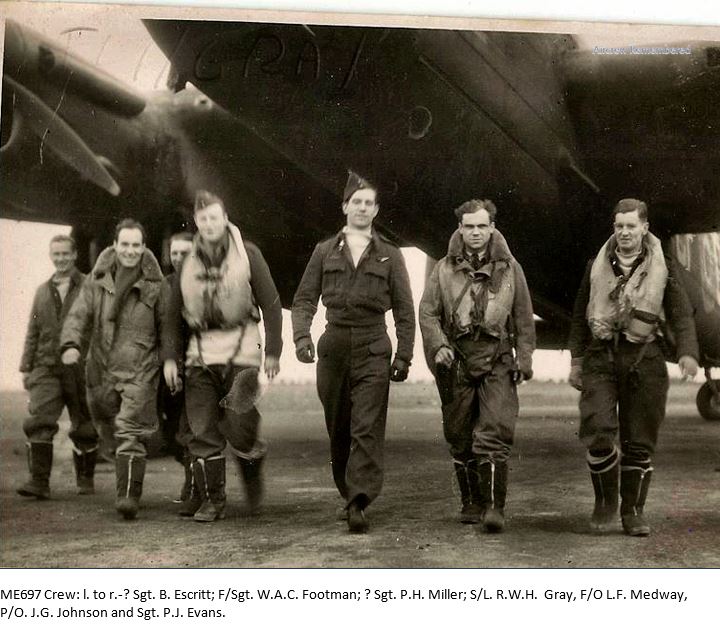
Two of the crew survived the attack by Uffz. Feilen, S/L Gray to become a POW and wireless operator, Sgt. Evans, who managed to evade and return to England. His account of the last moments of ME697 and her crew is riveting and nothing less than miraculous. The story as related by S/L Gray, after his liberation, is just as captivating and corroborates that of his WOP.
SECRET.
M.I.9/S/P.G. (-) 1992.
EVADED CAPTURE IN FRANCE.
The information contained in this report is to be treated as
SECRET.
STATEMENT BY
1387533 Sgt. Evans, Patrick John, 625 Sqn., Bomber Command, R.A.F.
Left: GIBRALTER, 23 Jun 44.Arrived: SWINDON, 24 Jun 44.
Date of Birth: 6 Sept 20.
R.A.F. Service: Since 11 Sept 41.Peacetime Profession: Clerk.
O.T.U.: No. 10 (ABINGDON).Private Address: 64, Coburg Buildings
Francis Street,
London, S.W.1.
Conversion Unit: No. 28 (WYMESWOLD).
Post in crew: Wireless operator.
Other members of the crew:
S/Ldr. GREY [sic] (pilot) (Believed safe in France)
F/Sgt. FOOTMAN (bomb aimer) killed
F/O MEDWAY(navigator) killed
P/O JOHNSON, R.C.A.F. (mid-upper gunner) killed
F/O Martin (engineer) killed
Sgt. ESCRITT (rear gunner) killed
I was a member of a crew of a Lancaster aircraft which took off from Kelstern about 2200 hrs on 3 May 44 to bomb CAMP DE MAILLY.
4 May 44, Baled out near VILLETHIERRY
We reached our target and about 0200 hrs (4 May), I believe we were hit by a fighter. A fire started near the rear turret. I tried, unsuccessfully, to put it out with the extinguisher. The mid-upper gunner then came forward and I took this to indicate that the pilot had given the order to bale out. I, therefore, put my parachute on and went and stood by the pilot. The aircraft then blew up and the pilot and I were blown clear. I came down by parachute in some woods about three kilometres North of VILLETHIERRY (FRANCE, 1:250,000, Sheet 16, X 5574).
I had sprained my back and ankle in coming down and from where I was I could see the aircraft burning. After burying my parachute I started walking. Three quarters of an hour later I found that I had been going in circles. When I came to VILLETHIERRY I got into a wheelbarrow in a farmyard and slept for about two hours. I then went into the fields and slept again.
5 May 44 Received help
About 0500 hrs (5 May) I spoke to a man whom I saw coming along the road. I asked him where I was and also if there were any Germans in the vicinity. He left me, returning in about an hour. He then took me to his house and gave me something to drink and a meal. From this point my journey was arranged for me.
INTERVIEWED BY: I.S.9 (W). O.R.S. Bomber Command R.A.F. European Intelligence, B.B.C. 24 Jun 44.
APPENDIX C.
Distribution: D.D.M.I. (P/ I.S.9. I.S.9(X). I.S.9 (W.E.A.). M.I.6.(for I.S.9(d) (2 copies). P/W & X Det. MIS, ETOUSA. I.S.9(W). M.I.5. File.
Distribution of this Report: D.D.M.I.(P/W). M.I.9. I.S.9. I.S.9(W). I.S.9(X). M.I.9(d). M.I.19. M.I.5. M.I.6.(for I.S.9(d) (2 copies). I.S.9(W.E.A.). M.O.1.(S.P.). A.I.1(a) P/W. A.L.O.,M.I.9. P/W & X Det. MIS, ETOUSA. Lt.Col. H.B.A. de Bruyne (3 copies). C.I.O., H.Q. Bomber Command, R.A.F. (7 copies). A.D.G.B. Coastal Command, R.A.F. Transport Command, R.A.F. Tactical Air Force, R.A.F. 38 Group, R.A.F. 85 Group, R.A.F. F/Lt. H. Furniss-Roe. File.
APPENDIX D.
Distribution: M.I.9(d). I.S.9. I.S.9(W). A.L.O.,M.I.9. P/W & X Det. MIS, ETOUSA. File.
The man that Patrick Evans had been fortunate to meet, was baker Aristide Saussey. He took him to his home in Villethierry where he met Aristide's wife, their child Pierre and assistant Charles. The local Mayor and his English speaking wife Gilberte were sent for and it was arranged that Evans should stay with the Sausseys for a week or so pending enquiries being made to contact an escape organisation.
On 11 May Patrick Evans was moved 10 miles east, to a house at the village of Pont sur Yonne where he remained for a further week until 18 May when two women Doctors arrived and took him by train to Paris. In Paris he stayed with a friend of one of the Doctors for three nights until 22 May before being moved to stay with a Paul and Olga Christol. Here he was joined by two American airmen and the three of them were later taken to a clinic where they joined about another 13 British and American airmen and several guides.
They were given instructions by Georges Broussine (see later) who asked them to say that they were 'sent by Burgundy'.
Charlie and Henri, their guides, then took them by train to Pau where they stayed until being driven into the foothills where they joined a mountain guide and 16 Jewish refugees.
The whole party left on 31 May and eventually crossed the border into Spain early on 3 June. Giving them directions to Ustarroz the guide then left them. After setting out once more they were arrested by Caribineros who took them first to Ustarroz where they were questioned and later to Isaba for further interrogation. On 4 June they were taken by bus to stay in a hotel in Pamplona where on 6 June they were visited by the British Consul's representative.
Patrick Evans left Gibraltar on 23 June, arriving back in the UK the following day.
One of those in the same escape party as Patrick Evans was Sqn Ldr. Ernest Neville 'Ned' Sparks the Main Force Deputy Controller, who's Lancaster JB402 had been shot down whilst home-bound.
A comprehensive account of Patrick Evans' escape and many others can be found in the book by Keith Janes entitled 'They Came from Burgundy' a study of the Bourgogne escape line set up by Georges Broussine. One of the most successful escape lines, the Bourgogne line helped some 327 men to make good their escapes from Nazi occupied France.
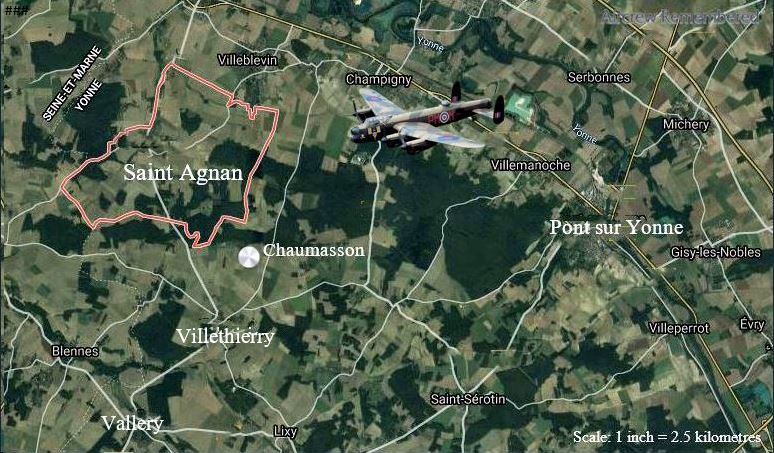
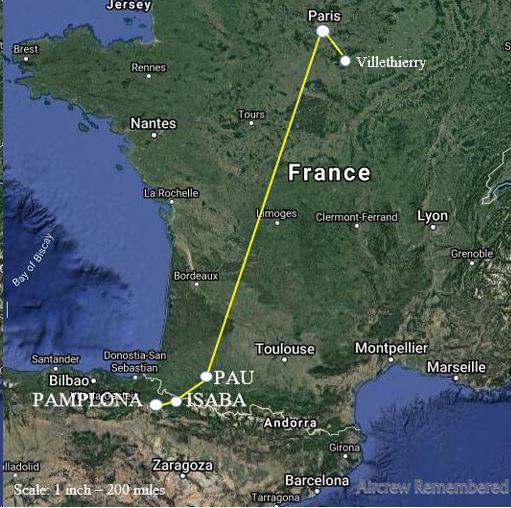
S/L Gray provided a statement after his liberation in May 1945. The date stamped on this document is 26 Apl 1946, the date of the interview 14 Jan 45 and that of his liberation May 45. It would seem that the date of the interview should be 14 Jan 46.
WO208/3340
SPG/Lib Reports 1403 - 1882.
N525 CLOSED UNTIL 1972
[The above references etc., are on front of file folder]
SECRET
M.I.9./S/P.G./LIB/1806.
The information contained in this report is to be treated as
SECRET
STATEMENT BY
134113 S/Ldr. Robert William Hyne Gray, 625 Sqn., R.A.F.
Captured: LE PERTHUS 9 May 44.Liberated: LUCKENWALDE May 45.
Date of Birth: 16 Nov 11.Peacetime profession: Chartered Surveyor.
R.A.F. Service: May 41.Private Address: District Valuer’s Office
14 Landsdowne Place.
HOVE
1. EVASION AND CAPTURE.
I was a pilot in a Lancaster which took off from KELSTERN, Lincs, at approx. 2100 hrs. on 3 May 44. The target was MAILLY-LE-CAMP. We reached it and bombed the objective and on the return journey was intercepted by two F.W. 190’s. Two engines were put out of action and the bomb bay and amidships were set afire. The aircraft finally blew up in mid-air. My parachute, I think, was blown open and I landed in a wood near CHAUMASSON (near CHAMPIGNY).
I was unconscious until the following morning.
On recovery, I made some rough felt shoes from the back of the parachute and then began moving South through the wood. Later I was picked up and taken to a farm in CHAUMASSON (par VALLERY, Tonne) belonging to Jerome BECKROUT.
He gave me assistance.
I stayed with him only one night 4/5 May 44 and left on the following morning. He obtained a ticket for me to NEVERS which I reached without incident. After walking some distance, I managed to catch another train to TOULOUSE. From there I reached PERPIGNAN by train and from there began walking. After some time I set out for LE PERTHUS on the Spanish border where I was challenged by a German soldier who took me back into the town.
2. CAMPS IN WHICH IMPRISONED.
(1) Stalag Luft III, S.G.N.Aug 44- Jan 45.
(2) Oflag IIIX, LUCKENWALDE Feb- May 45.
3. ATTEMPTED ESCAPES.
NIL.
4. LIBERATION
I was liberated from LUCKENWALDE in May 45.
INTERVIEWED BY I.S.9 (w). 14 Jan 45.
APPENDIX A. Distribution: I.S.I.S.9 (R.B.) (2 Copie) I.S.9 (W).
Distribution of this report. M.I.9/19 (G)M.I.9 (c). I.S.9 (R.B.) (2 Copies).I.S.9 (w). X.I.1 (a)P/w (2 Copies) A.L.O., M.I.9. H.Q. Bomber Command R.A.F. Hist. Sect. Air Ministry. File.
SEAL:
GENERAL STAFF
DIRECTOR OF MILITARY INTELLIGENCE
M.I.9.
26 APR 1946 2530
So near yet so far - the key stages of Sqn/Ldr. Gray's attempted evasion

Sqn Ldr. Currie in Battle Under the Moon, provides additional details on the loss of ME697. The source of this account is unknown.
'A-Apple had been hit and set on fire by a night-fighter’s cannon-shells, and the fuselage, aft of the flare-chute, had become an inferno. The rear gunners only hope of survival would have been to jump at once. Sergeant Escritt, however, had stayed in the turret, giving his captain instructions for evasive action. ‘It’s burning in the turret,’ had been his last words. ‘The flames are all around my arms.’ When the aircraft exploded, Squadron Leader Gray and the wireless operator, Sergeant Evans, had been flung into the night… The heroic rear gunner died with the other four members of A-Apple’s crew.'
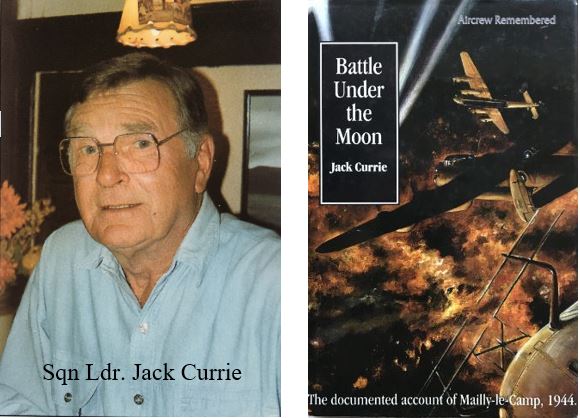
Of the 15 aircraft detailed by 625 Squadron to participate in this raid, twelve managed to bomb the target and return to base, with the exception of P/O S.H. Beetham and crew in W4263. They were attacked by fighters and due to damage landed at LASHAM. One other aircraft was damaged by a fighter attack and several crews were critical of the marking and the performance of the Master of Ceremonies. Bombing times ranged from 0013 to 0032, indicating that most bombed with the second wave, not the first as assigned. This was most likely a contributing factor to the Squadron’s high loss rate. Of the returning crews only 2 reported bombing on the green spot fires marking the special target, 7 bombed on the red spot fires marking the main target, 2 did not state on which colour markers they had bombed and one reported bombing on yellow target indicators (yellow target indicators were used to mark the assembly point).
Sadly, the Squadron would lose three of their crews from the Mailly-le-Camp debacle:
ME697 with S/L. R.W.H. Gray and crew, LM515 with P/O. Neil McArthur McGaw and crew and LM317 with P/O. Charles David Angelo Short and crew. Tragically, there were no survivors from the crews of either LM515 or LM317.
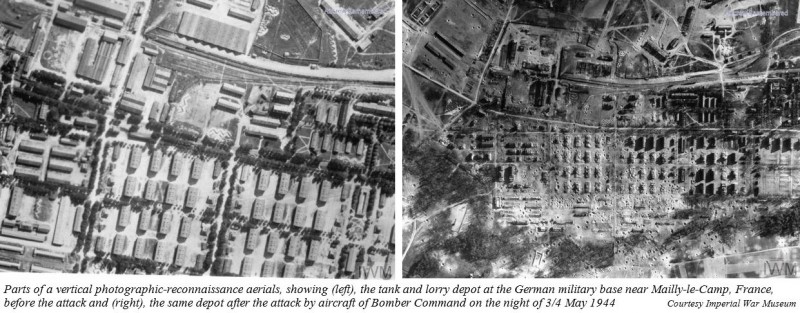
A successful raid, or was it?
The raid post-mortem revealed that the whole of the target was severely damaged, in particular the barrack buildings and workshops. Casualties included 218 killed and 156 wounded. 102 vehicles were destroyed, including 37 tanks. 80% of buildings were destroyed and 20% damaged. This is interesting as this military depot had the capacity for 5000 soldiers and up to five tank battalions. One cannot help but wonder how many soldiers and vehicles were moved to safety, given the five minute hiatus between the target markers going down and the obliterating destruction of the first wave of 5 Group Lancs.
The grievous cost
Bomber Command would pay dearly, with the loss of 42 Lancs and their crews. 304 airmen failed to return to base: 253 KIA (83%!), 19 POWs and 32 evaders. Four men were missing from returning aircraft, their fates never known. Of the 42 aircraft lost, 26 or 62% had no survivors. This was a most costly raid for the Command. As S/L Currie extrapolates, that if the raid was executed with clockwork precision, an estimate of one hundred aircrew would not have lost their lives. This would have brought down the loss rate to a still high 8.1% but acceptable taking into account moonlight and proximity to a plethora of Nachtjagd bases.
Nachtjagd War Diaries Volume Two provides a graphic description of how this raid was tracked and attacked in a methodical manner. The time frame of the forty-two victories is chilling. Between 0010 and 0055 of May 4 thirty-six Lancs were destroyed with deadly efficiency. Two Nachtjagd Experten would account for a quarter of the losses: Hptm. Helmut Bergmann six claims in thirty minutes and Hptm. Martin Drewes five in fifty-two minutes! Their combat reports give some idea of just how one-sided this battle was and the deadly efficiency of the schräge musik weapon system in the hands of a skilled competent crew. Hptm. Bergmann and his crew would fall victim to F/Lt John Surman flying 604 Squadron Mossie, MM449 on 25/26 July 1944. At the time his night victories stood at 34. Hptm. Drewes would survive the war with a total of 43 night and 5 day claims. These would include 625 Squadron’s ND641, taking the life of the author’s namesake uncle.
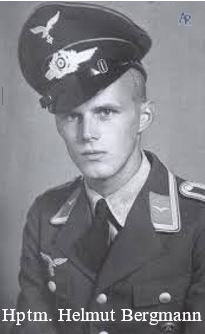
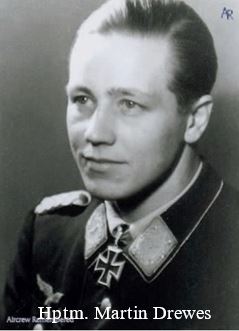
THE LOSSES
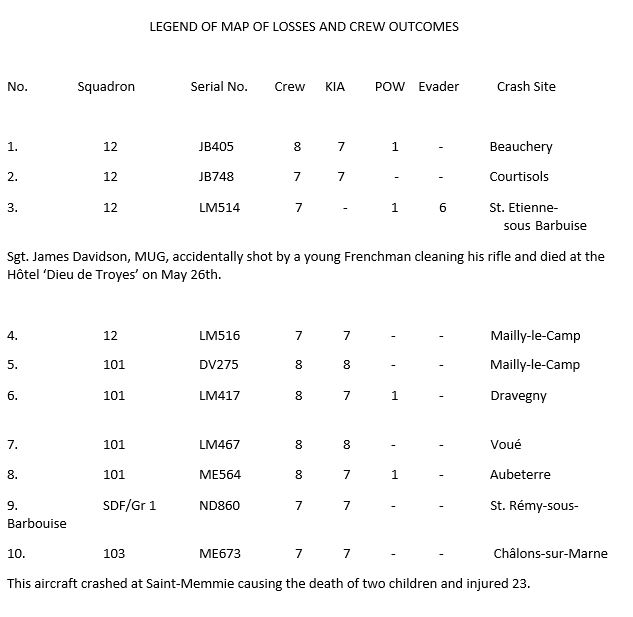
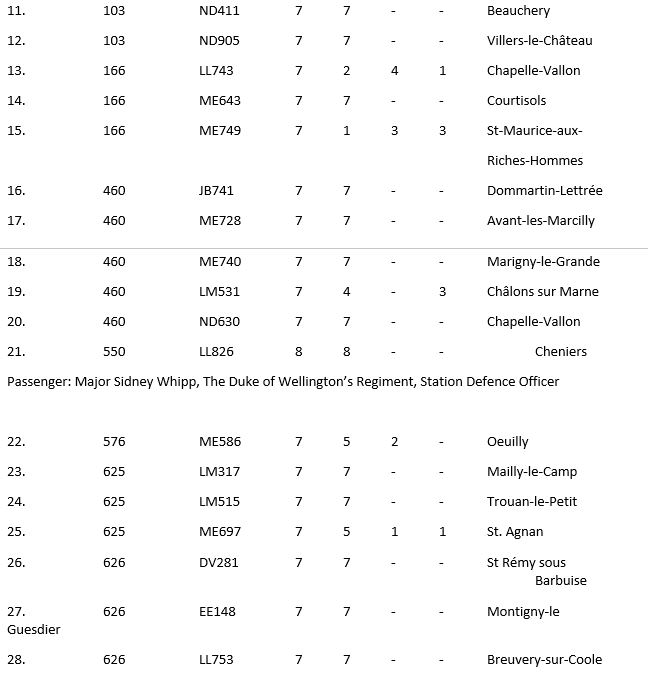
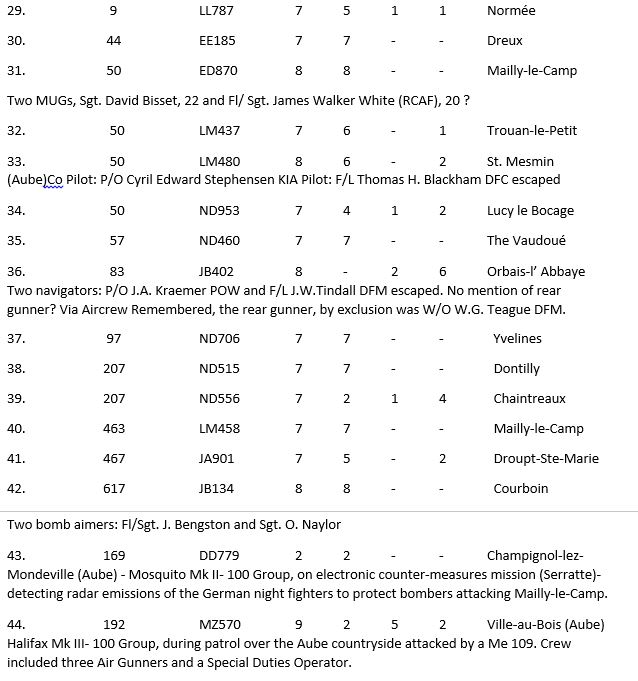
Crash sites of the 44 losses listed above
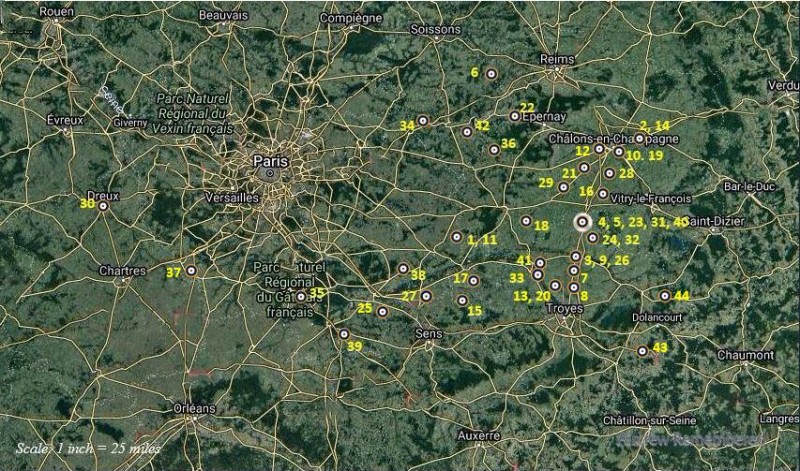
During this evening of horrific losses, there was a miraculous survival. Nineteen year-old rear gunner of 101 Squadron’s Z-Zebra, Sergeant Jack Worsfold, found himself in an untenable situation. On the bomb run his aircraft was bullet riddled, the starboard outer afire and the Skipper’s urgent command to 'Bale out, bale out!' In disbelief, he found his parachute shredded. At 7500 feet, on his hands and knees, he suddenly felt himself falling free. He remembered a severe blow to the chest, hand pain, then nothing. He regained consciousness in a smouldering gorse bush, with a section of the aircraft’s fuselage lying fifty yards away. It was apparent that after a significant free fall, he was catapulted by high tension wires into a nearby fir tree, ultimately falling onto a gorse bush cushion! His price for survival was fractures of the thigh, shoulder, three ribs, two fingers and burns of face and chest. His youthful resilience, coupled with the medical attention of a French village doctor and the dedication of the staff of a German military hospital, enabled him to survive to tell the tale.
BIOGRAPHICAL DETAILS OF THE CREW
(1) Sqn Ldr. Robert William Hyne Gray DFC, was born on 16 November 1911 at Richmond Surrey the son of William Henry Gray (a Motor Works Manager) and Ellen Mary Gray nee Smith of 88 Selwyn Avenue Richmond.
In 1939 he married Eileen D. Potter at Manchester and they later lived at 45 Friar's Road, Sale, near Manchester
Prior to joining the RAFVR Robert Gray was a Chartered Surveyor
On 12 June 1937 he was appointed a Third Class Valuer of the Inland Revenue Department (London Gazette 9 July 1937)
On 10 November 1942 1535803 Corporal Robert William Hyne Gray was commissioned as a Pilot Officer on probation (emergency) (London Gazette 9 March 1943).
Details of his promotion to Flying Officer are not known.
He was promoted to Flight Lieutenant (war subs on 10 November 1944 (London Gazette 1 December 1944)
Acting Squadron Leader Robert William Hyne Gray was awarded the Distinguished Flying Cross on 21 December 1945 as promulgated in the London Gazette of the same date.
625 Squadron - Operations Book - Appendices RAF form 540 – Summary of Events - Secret Compiled by F/Lt Eaglesfield (Adjutant)
3.5.1944 – MAILLY-LE-CAMP
Operations: 15 aircraft were detailed for Operation, the target being Mailly-le-Camp. Once again a target in FRANCE was chosen as the rendezvous for the ‘heavies’ of Bomber Command. From the reports from crews, it would appear that the bombing of the target was fairly good. Certainly the troops stationed at this camp would have great difficulty in being at ‘reveille’ on time due to the visit, as many large explosions took place on the camp itself and also in the tank Park, which would be unserviceable for quite a long time. The M.C. did not appear to be too good and confusion was evident. Three of our aircraft failed to return from this Operation. A fairly large bomb load was taken on this trip, and the weather over the target was very good. It was with great regret by all from the ‘Squadron Commander’ down to the ‘lowest’ and it was necessary to place on record that the Flight Commander of ‘A’ Flight failed to return from this Operation – F/L/A/S/L. RWH GRAY. This officer, although he had only been the Flight Commander for a short time, had welded together not only a good crew, but a Flight in which all the members of it had learned that he could be looked up to in every sense of the word. His loss will be greatly felt by all who knew him, and all the Squadron sincerely hope better news than ‘missing from operations’ will be the case in a short time.
Russell Margerison in his book, Boys at War, provides an insightful vignette of bomber crew down time. After the disastrous Nuremberg raid crews were detailed to participate in a “Wings for Victory” week march past at the seaside resort of Mablethorpe, with a WAAF and ATC contingency, headed by a RAF band.
'Acting Squadron Leader R.W.H. Gray reluctantly accepted charge of the parade, knowing full well that marching was not our strong point. He assembled the crews in a dingy back alley on the outskirts of town and in a not too confident voice said:
"Now come on chaps, don’t muck about, get yourselves in threes. We’ll have to put some sort of a show on, after all we are leading the march past."
'With humorous, unprintable replies raining on him from all directions, cigarettes were "docked”, hands removed from pockets and ties roughly straightened as we shuffled into some semblance of order, ready to march out to meet up with the rest of the parade.
The sea-front at Mablethorpe was lined on both sides with a goodly number of people, including many soldiers, who no doubt would be justifiably critical of our half-hearted attempt at marching, especially when the WAAFs were putting up a very smart show behind us. However all went well up to the saluting base, but as soon as that had been passed the lads began to duck out of the ranks thick and fast and in no time at all Sqd/Ldr. Gray was left alone, ahead of a great gap, marching smartly behind the band. Pity really, for he was a good sort'
Robert Gray relinquished his commission under the provisions of the Navy, Army and Air Force Reserve Acts, 1954, and was granted permission to retain his rank of Squadron Leader with effect from 16 November 1956 (London Gazette 25 January 1957)
He died at Hove East Sussex on 26 January 1987 aged 75. His address at the time of his death was 41 Palmeira Avenue, Hove.
(2) F/O. David Charles Martin MiD was born in 1915 at Morpeth, Northumberland the son of Charles Martin DCM (a Public Works Contractor's Labourer) and Catherine Martin nee Lamb.
David Martin had three siblings: Frederick J. Martin born 1917, Irene Martin born 1921 and Margaret Martin born 1924.
In 1939 the family lived at 24 Duncans Gardens Morpeth.
In 1939 David Martin married Anne Morallee (marriage registered at Northumberland Central). Their son David C. Martin was born in 1940 and they later lived at 11½ Station Road, Ashington
534559 Sergeant David Charles Martin was commissioned as a Pilot Officer on probation (emergency) on 27 May 1943 in the General Duties Branch of the RAF. (London Gazette 20 July 1943), confirmed in this appointment and promoted to Flying Officer on probation (war subs).
In the London Gazette of 8 June 1944 it was promulgated that he had been Mentioned in Despatches.
He is commemorated on the Morpeth War Memorial, Castle Bank, Morpeth.
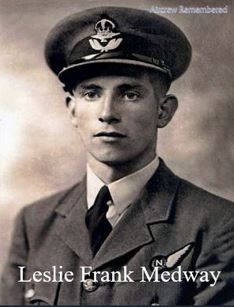
(3) Leslie Frank Medway was born on 5 December 1923 at Camberwell, the only son of Frank Stanley Medway, a railway clerk, and Caroline Alice Medway, nee Tucker. He had eight siblings: Jose M. Medway born 1922, Olive B. Medway born 1925, Doreen M. Medway born 1926, Irene M. Medway born 1927, Jean M. Medway born 1930, Margaret E. Medway born and died 1931, Barbara A. Medway born 1933 and James L. Medway born and died 1945.
In 1939 the family lived at 20 Small Gains Cottages Sawbridgeworth and later at 20 West Road, Sawbridgeworth, Hertfordshire.
Leslie attended school at Fawbert and Barnard’s Primary School, Harlow. At age twelve he was awarded a scholarship to prestigious Bishop’s Stortford College where he excelled in mathematics. In addition he was a gifted athlete, recognized for his prowess in cricket, rugby and football. He was re-awarded his cricket colours for 1940.
During his attendance at Bishop’s he was an active member of the Air Training Corps, No. 1096 Squadron. His Certificate of Service, General Remarks provide some insight of how unique of a young man he was:
First class athlete. Played cricket for gentlemen of Essex. Keen Rugby player. First class swimmer and water polo player.
PLENTY OF GUTS. I am sure that he will respond well to J.T.W. training and will develop into a reliable pilot. I recommend him.
Signed E.N. Griffiths Flt/Lieut
Officer Commanding 1096 Squadron
Date 1st April 1942
1601114 Leading Aircraftman Frank Leslie Medway was commissioned as a Pilot Officer on probation (emergency) on 15 May 1943 (London Gazette 29 June 1943). He was confirmed in that appointment and promoted to Flying Officer (war subs) on 15 November 1943 (London Gazette 19 November 1943).
Leslie Frank Medway is commemorated on the War Memorial at Great St. Mary’s Churchyard at Sawbridgeworth.
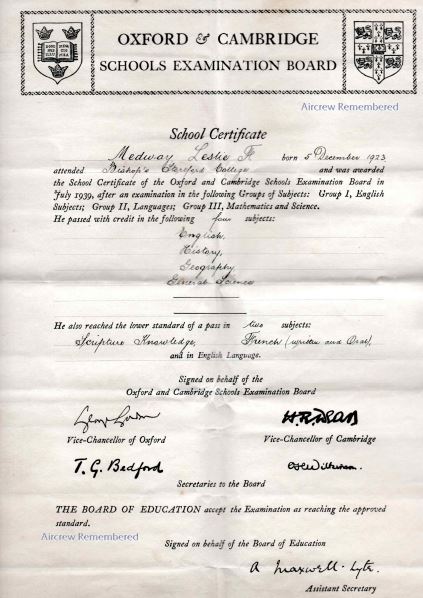
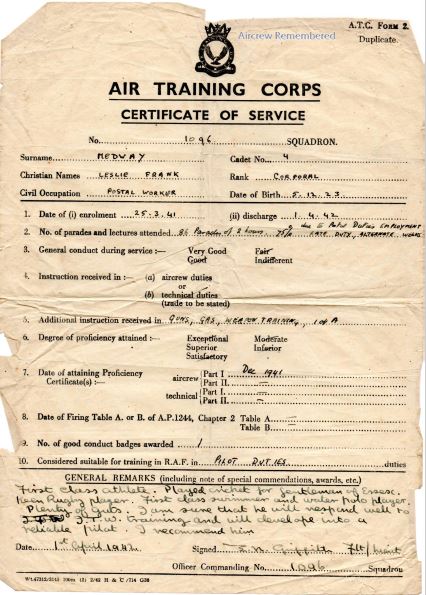
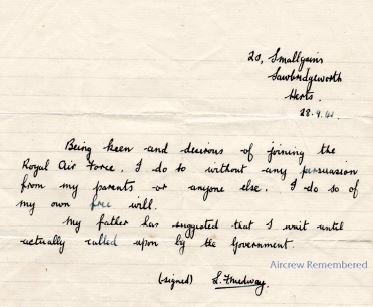
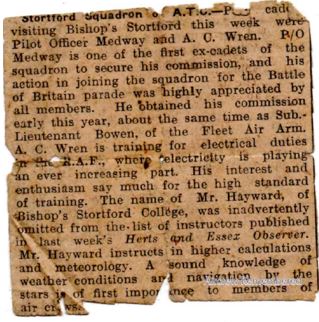
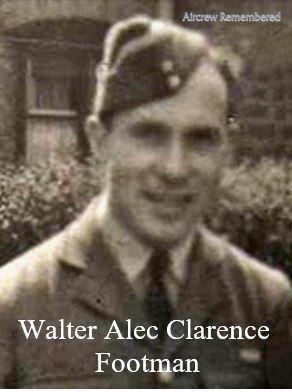
(4) F/Sgt. Walter Alec Clarence Footman was born on 11 December 1919 in Medway, Kent the only child of Walter Ernest Footman (an Omnibus Driver) and Ella L. Footman nee Chapman. In 1939 the family lived at 84 Exeter Road, Bournville, Birmingham and later at 181, Mary Vale Road, Bourneville, Birmingham.
In 1941 he married Phyllis Irene Stephens at Birmingham
(5) Sgt. Patrick John Evans was born on 6 September 1920 in London the son of Robert J. Evans (a Commissionaire) and Elizabeth M. Evans nee Calnori. He had one sibling: Violetta Evans born 1914.
In 1939 the family lived at 21 Coburg Buildings, Francis Street, Westminster, London at which time Patrick Evans was employed as a Hire-Purchase Clerk.
He enlisted in the RAFVR on 11 September 1941 and trained at:
10 OTU at RAF Abingdon in Oxfordshire
28 CU Wymeswold (according to Lib Report but it was 28 OTU at Wymeswold NOT 28 CU. Formes May 1942)
He lived at 64 Coburg Buildings, Francis Street, London SW1.
He died at London in 2004
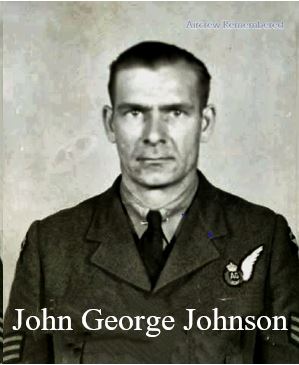
(6) P/O. John George Johnson was born on 18 January 1913 at Fort Frances, Ontario, Canada the son of Finnish born parents John William Johnson (died 1939) and Sanna Johnson nee Bouttu (died 1920). He had three siblings Victor Johnson born c 1903, Arvo William Johnson born c 1909 and Elma Johnson born c 1911. The family lived at 224 S. Franklin Street Fort William Ontario
John Johnson was educated at Public School 1919-1924 and High School 1924-1925. After leaving school he was employed as a Seasonal Trackman for CNR Fort Frances 1929-1937 before being laid off then as a Carpenter/Fitter for Fort William Parks Board July-Oct 1939 before again being laid off. He then worked as an Aircraft Fitter for Canadian Car and Foundry Aircraft Manufacturers from February 1941 to joining RCAF.
He enlisted at Winnipeg, Manitoba on 1 July 1942 when he was described as being 5' 9½" tall weighing 163lbs with a medium complexion grey eyes and brown hair.
After training at 3 Wireless School RCAF Winnipeg, Manitoba and 3 Bombing and Gunnery School at RCAF MacDonald, Manitoba he was awarded his Air Gunners Badge and promoted to Sergeant on 11 June 1943.
He embarked for the UK on 23 June and after disembarking on 1 July was posted the next day to 2 Personnel Reception Centre a Bournemouth. On 9 July he was posted to No 28 Operational Training Unit at RAF Wymeswold, Leicestershire for night bomber training on Wellingtons. At 28 OTU he trained on Course No. 17 from 25 June to 14 August. On 15 August he was posted to 1656 Conversion Unit at RAF Lindholme in the West Riding of Yorkshire.
He was posted to 625 Squadron at RAF Kelstern, Lincolnshire on 11 November 1943.
On 11 March 1944 he was promoted to Flight Sergeant and commissioned as a Pilot officer on 4 April 1944
(7) Sgt. Benjamin Escritt was born in 1921 at Hull, East Riding of Yorkshire the son of Benjamin Escritt and Edith Clara Escritt nee Walpole. He had three siblings: Violet Escritt born 1922, Edith Escritt born 1925 and John Escritt born 1927.
Benjamin Escritt senior died in 1927 at the age of 27.
In 1939 his widow Edith lived with three of her four children at Wilfred's Terrace Westbourne Street Kingston-upon- Hull.
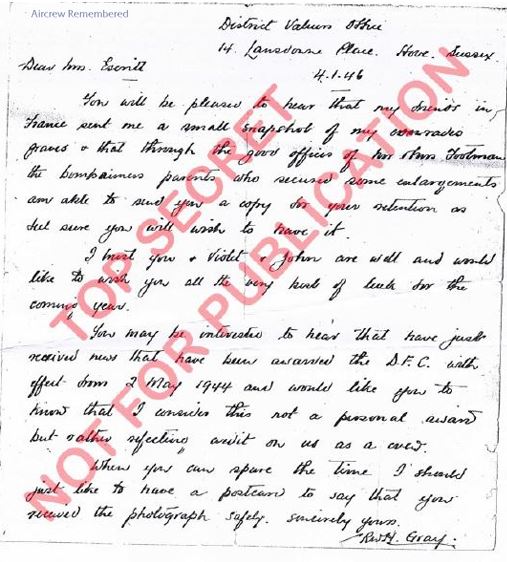
BURIAL DETAILS, MEMORIALS AND EPITAPHS
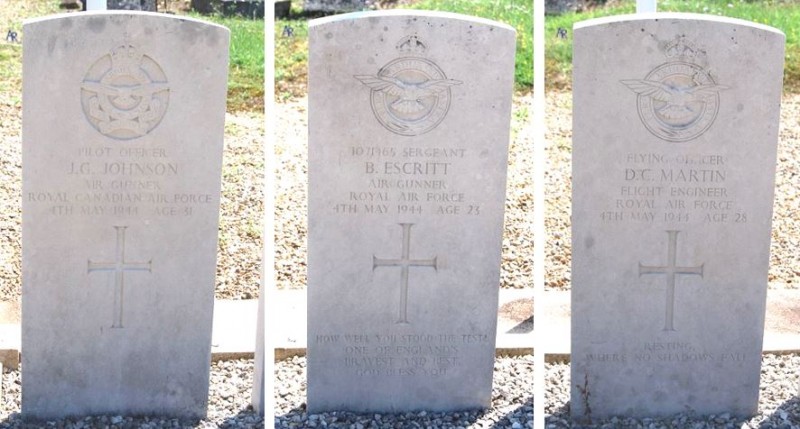
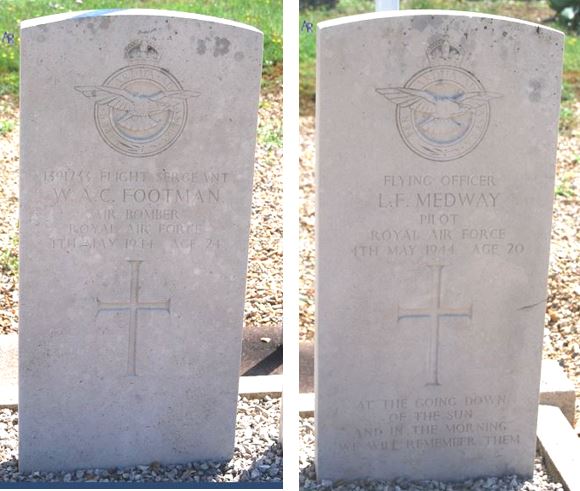
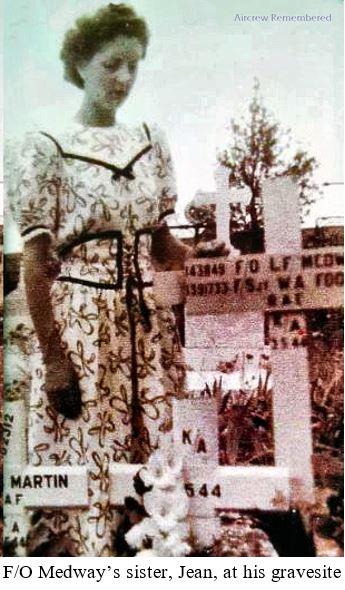
(2) F/O. David Charles Martin was buried at St. Agnan Communal Cemetery, Plot E. Row 1.Grave 3.
His epitaph reads:
Resting,
Where no shadows fall
(3) F/O. Leslie Frank Medway was buried at St. Agnan Communal Cemetery, Plot E. Row 1. Joint Grave 4-5.
His epitaph reads
At the going down
Of the sun
And in the morning
We will remember them
(4) F/Sgt. Walter Alec Clarence Footman was buried at St. Agnan Communal Cemetery, Plot E. Row 1.Joint Grave 4-5.
No epitaph
(6) P/O. John George Johnson was buried at St. Agnan Communal Cemetery, Plot E. Row 1.Grave 1.
No epitaph
(7) Sgt. Benjamin Escritt was buried at St. Agnan Communal Cemetery, Plot E. Row 1.Grave 2.
His epitaph reads
How well you stood the test
One of England's
Bravest and best.
God bless you
Decoration Suggestions:
134113 S/L R.W.H. Gray DFC: Bar to DFC, POW
52312 F/O D.C. Martin: DFC, KIA
143849 F/O L.F. Medway: DFC, KIA
1391733 F/Sgt W.A.C. Footman: DFM, KIA
1387533 Sgt P.J. Evans: DFM, Evader
J85585 P/O J.G. Johnson: DFC, KIA
1071465 Sgt B. Escritt: DFM, KIA
Author’s Notes:
This has been a challenging and educational archive report. I am grateful to the Medway family for their contribution and understanding and to Maria Choules at CWGC for her patience and perseverance in our attempts to resolve the mystery of how ME697, with a crew of seven, had two pilots. The 625 Squadron ORB listed S/L Gray as the captain/pilot for each of their ops. However, the headstone in St. Agnan Cemetery indicates F/O Medway’s post as pilot. The origin of this ambiguity remains uncertain, without resolution.
The sequence of events during the final minutes of ME697’s existence are precisely and vividly recounted in the reports of the two survivors. It is noteworthy that they accurately concur with each other. The fact that Sgt. Evans had ascertained that the ‘cookie’ had not hung up and the wings were not on fire would have reduced the risk of an explosion, giving the crew time to plan their bale out strategy. Also, it would appear that some crew members were rendered unconscious as they were explosively ejected into the night, the chutes of S/L Gray and Sgt. Evans being deployed by the force of ejection. Sgt. Evans regaining consciousness during the descent, S/L Gray later in the morning.
I am most grateful to co-submitter, John Naylor, for introducing me to S/L Jack Currie’s book, Battle Under the Moon. Without it this report would be without substance.
In retrospect it is always interesting to assess if lessons were learned from mistakes made. With this raid the mistakes included overkill, communications failure, moonlight conditions, target proximity to numerous night fighter bases, a prominently marked assembly-point and a bomb load that included 4000 pound ‘cookies’, mixed with low level marking. There was no room for error without exponentially increasing the loss rate. The breakdown in communications at a critical point in the raid left two thirds of the crews orbiting the marked assembly-point in brilliant moonlight, with a full complement of night fighters already infiltrated into the bomber stream— could only spell disaster as the field of combat was tilted to near vertical in favour of the enemy. Akin to kicking a hornets' nest in the nude. Under the circumstances it is not difficult to understand the breakdown in R/T silence protocol. Also, it was not surprising that the day following the raid, the master crystals of the Master Bomber frequency were removed from every main force aircraft. In future, Skippers would receive their instructions but never again would they be able to vent their anger, frustration or provide critical information. However, it would take the heavy losses of a ‘milk-run’ to Occupied Europe a week later before the one third of a mission edict would be rescinded. Much more disturbing was the fact that the lesson of planning a raid in moonlight conditions would not be finally drilled home until the disastrous Vierzon raid that would cost 625 Squadron the record loss of four crews and three aircraft. (http://aircrewremembered.com/knowles-wilfred-martin.html). As if Nuremberg and Mailly-le-Camp were not enough.
Sqn Ldr. Jack Currie did not participate in this raid but made the following comment:
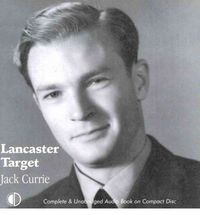
'And so to the questions which, while writing the story, have often come to mind: ‘What would my mental attitude have been, over the assembly-point? How would I have liked it, orbiting a marker for fifteen minutes in the moonlight among the rest of 1 Group and a pack of night-fighters? The answer to the question never changed- I would not have liked it. I would have complained. Not with the transmit button pressed - RT discipline, as opposed to any other kind, was strict within the crew - but on the intercom…'. These sentiments were echoed by George Wilson of 626 Squadron: 'The most memorable part of the whole operation, was when we were circling the ground marker, tethered like live bait, watching aircraft explode in the air and on the ground. Voices on the RT began to show signs of strain.'
In the aftermath one mystery remained unsolved: the frequency disruption by the American news broadcast and the pop songs, The Yellow Rose of Texas /Deep in the Heart of Texas on channel “C”. One plausible explanation was a radio counter-measure by the enemy. If true, how chillingly effective. We may never know but more to follow.*
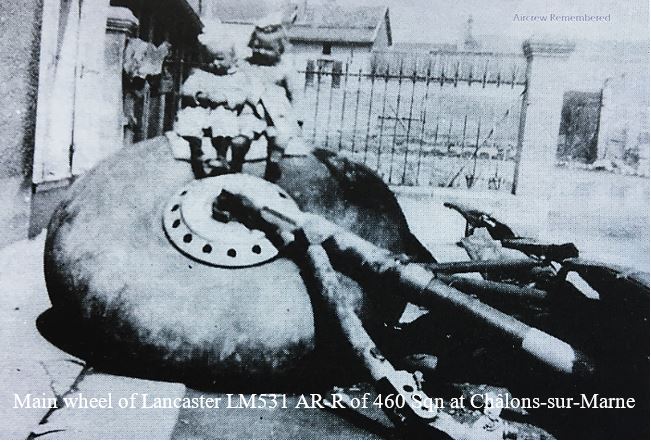
Murphy’s Law, an adage that states: 'Anything that can go wrong will go wrong'. When one considers the complex variables of this raid that had the potential to guarantee failure, it is mind boggling that it was allowed to proceed or even be conceived. With all the information available during the planning phase, it is unfathomable that someone in Bomber Command senior staff did not have the foresight to predict disaster and cancel this raid. It is fortunate that the losses were not even greater. There can be no doubt that this raid represented a most resounding trouncing for Bomber Command.
In the POW camps there was a stock question that 'Kriegies' posed to each other: 'Which was your worst trip?' It was not surprising when a seasoned rear gunner, shot down half way through his second tour of ops, responded without hesitation: 'Mailly-le-Camp.' And to think that it was to count as only one third of a mission. Overnight, the daunting task of surviving of a contract of thirty operations became the impossibility of ninety! One can only imagine the increase in LMF cases if this policy had not been promptly rescinded.
*In follow-up regarding the mystery of the communication breakdown in the order by W/C Deane for the first wave to bomb, Theo Boiten has provided his wisdom of the theory that the Germans caused this with electronic countermeasures:
'I don't think that there is any validity in the idea that an American broadcast during the ill-fated Mailly-le-Camp raid of 3/4 May 1944 was actually a form of German electronic countermeasures jamming. I have not found a single piece of primary source evidence that would point in this direction …'
John Naylor has provided one of the most plausible explanations for the inadvertent jamming of the critical Master Controller’s frequency:
'I have to say I find it intriguing that this potentially dangerous event was not investigated further at the time! In the absence of any other explanation, there is one scenario that may not have been apparent at the time. The fact that the interference was of an American nature could lend credence to evidence that there were indeed American aircraft operating that same night, and in the same area! These were the B24D Liberators of the 801st Bomb Group and its' four squadrons operating out of RAF Harrington. Painted Matt Black, they had been stripped of their American Radio and Navigational aids, and been fitted with the same equipment being carried in both the Master Bombers Mosquito, and indeed the Main Force Lancasters. This equipment included Gee, Eureka and Rebecca sets, plus an 'S' phone for contact with ground agents in occupied Europe. Code named "Carpetbaggers", (American slang for an opportunist visiting salesman), they were part of, and worked alongside No. 100 (Bomber Support) Group RAF. Their role was the support of resistance fighters, in the form of dropping supplies of weapons, ammunition, communications equipment, and other items. They also dropped SOE and OSS agents into selected areas, as and when required, in the busy period working up to D Day, that was only a short few weeks away. In fact, on every moonlit night from January 1944 to May 1945, “Carpetbaggers" roamed at will over occupied Europe on clandestine missions.
Though flying at only 1000', it is not beyond the bounds of possibility that an operator on one of these aircraft had inadvertently left a transmit button on, in the appropriate wavelength, whilst listening in to an American news broadcast, along with the 'Yellow Rose of Texas' [or 'Deep in the Heart of Texas'] being played in the background?
Perhaps we will never know! '
Sources:
American Air Museum in Britain (website)
The Mighty Eighth War Manual by Roger A. Freeman
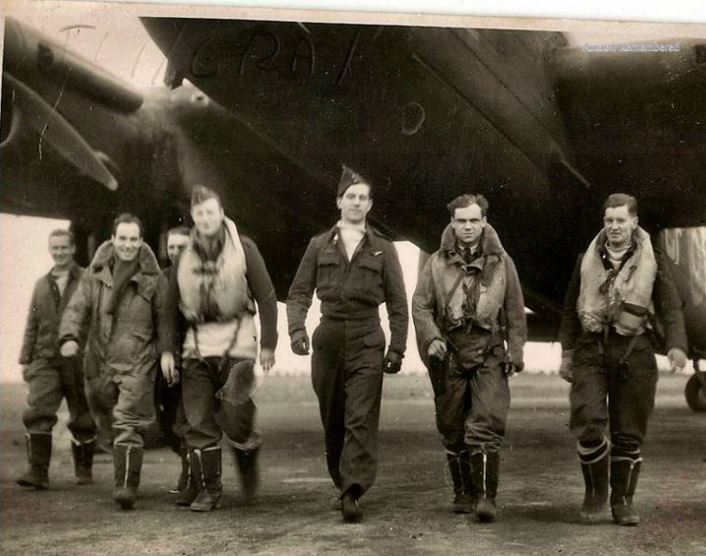
A picture is worth a thousand words, and on occasion many more!
We are particularly anxious to determine positive identification of each of the airmen in the above photograph. If you have any information that may assist our quest please contact the Aircrew Remembered Helpdesk
Controversy surrounds the photo of this crew that was acquired from the collection of Eileen Edge, courtesy of her son Ken Ball. Eileen was member of the WAAF who served with the 625 Squadron administration department at Kelstern. See photograph of Eileen below.
John Naylor has been able deduce that the Lancaster in the background is most likely ME594, CF-B, the crews mount for their seventh op to Berlin on 15 February 1944.
With this in mind our tentative IDs for the crew from left to right are: ? Sgt. Escritt, F/Sgt. Footman, ? Sgt. Miller, S/L Gray, F/O Medway, P/O Johnson and Sgt. Evans.
John is confident that the two crew members, second from the left and second from the right are gunners, indicated by their electrically heated flight suits. However, the individual photos of Footman and Johnson are also quite convincing of their IDs in this photo. With this in mind and presuming that this is a posed photo for unknown reasons, we are identifying F/Sgt. Footman as second from the left despite his electrically heated suit.
This is as close as we can come with the IDs in a letter dated 6 December 1995 by Sgt. Evans which provides the following information: 'Reading from left to right as follows:- John George Johnson (31ys) Mid upper gunner, Walter Alec Clarence Footman (24) Bomb aimer, then Ben [Escritt] very much in the background infortunately, ?G [?] or Gray pilot, he died 3yrs ago. Leslie Frank Medway (20) Navigator, Ian [?] Clackett Engr. He deserted over some woman in Grimsby, his place was taken by David Charles Martin, finally myself, Radio op (23) [Evans]'
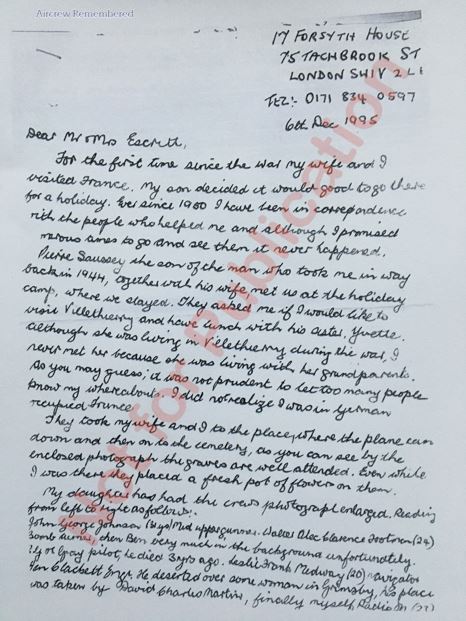
It is noteworthy that the reverse of this photo is labelled: ‘F/L GRAY’. One’s initial impression is that the Skipper of this crew is the crew member third from the right. In December 2019, the Medway family including F/O Medway’s youngest sister, Barbara, have positively identified this individual as F/O Leslie Frank Medway. This is supported by what appears to be the navigator’s insignia above his left tunic pocket.
This appears to be a happy, close knit crew. The photo was supposedly taken before an op to Berlin. A member of the Medway family reported that the photo was taken by a National Press photographer. One can only hypothesize the rational for this shot. It is most intriguing that the youngest member of the crew, F/O Medway, age 20, has the aura of being a dominant member at this juncture of their tour.

THE MYSTERY OF LANCASTER ME697: TWO PILOTS IN A SEVEN MAN CREW
During the research of this archive report it became obvious from the review of the Squadron ORB that Sqn Ldr. Gray was the Pilot/Captain of this crew for the previous operational flights and F/O Medway served as the Navigator.
The Commonwealth War Graves Commission website page for 143849 F/O Leslie Frank Medway indicates on the Graves Registration Report, 22 June 1956 and Headstone, his crew position as Pilot. The master page has recently been amended to note his crew position as Navigator, previously, Pilot. The St. Agnan Communal Cemetery headstone for F/O Medway is inscribed with his crew post as PILOT.
The Commonwealth War Graves Commission have so far been unable to determine how or why F/O. Medway was originally recorded as the pilot in their Graves Registration Report or his Headstone.
Stanley Medway, a disabled WW I veteran, the father of F/O Medway was adamant to his death that his only son was at the controls of ME697 when she crashed in the vicinity of St. Agnan Yonne. Unsubstantiated testimony by his living sister is that her brother received regular dual instruction by S/L Gray.
The citizens of St. Agnan Yonne, for the last seventy-five years have held a commemoration to celebrate the sacrifice made by the five airmen who lost their lives when ME697 crashed adjacent to their village. The headstone in the village cemetery denotes that F/O L.F. Medway as the PILOT of this aircraft. https://www.lyonne.fr/saint-agnan-89340/actualites...
Le pilote évite le village. Le pilote a réussi à dévier son avion afin qu’il ne s’écrase pas sur le village, mais le crash a fait cinq morts, un prisonnier et un évadé.
English translation
The pilot avoided the village. The pilot manoeuvered his aircraft in order that it did not crash on the village, but left five dead, a prisoner and an evader.
To date we are left with a dilemma, without an answer given the information available. Requests are pending from the RAF Museum, Air Historical Branch, the village of St. Agnan Yonne archives and Nachtjagd Combat Archives, with reference to the details of the final moments of ME697. We are hopeful that official documents, eyewitness accounts and/or combat reports will put this to rest for all involved. In the end, was the final scenario of ME697 and her crew a mid-air explosion/breakup or a forced landing that went awry? Until more information is forthcoming, this archive report will remain open for amendment. JEA
PHOTOGRAPHS FROM THE 60th ANNIVERSARY COMMEMORATION 12 May 2004
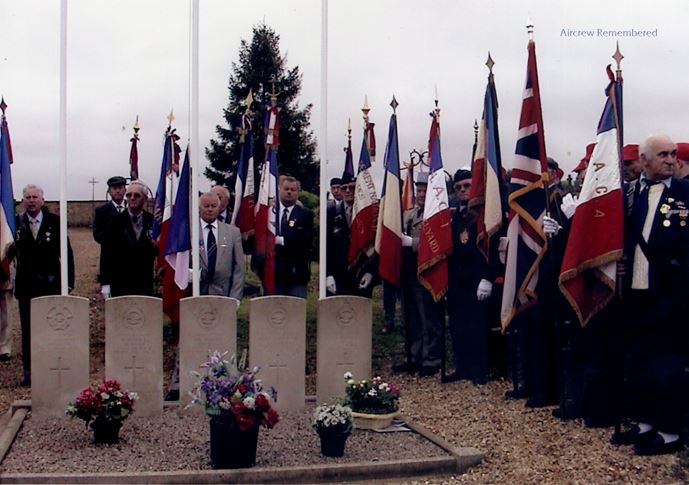
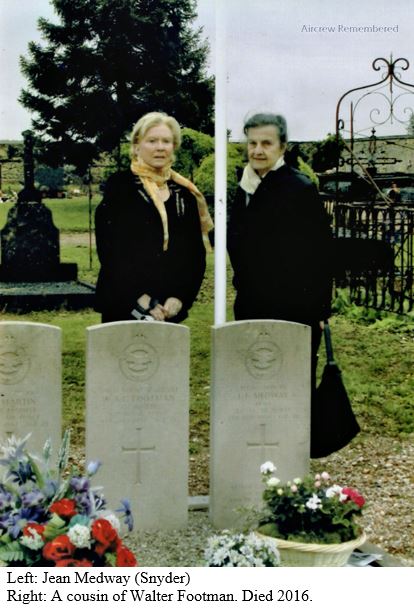
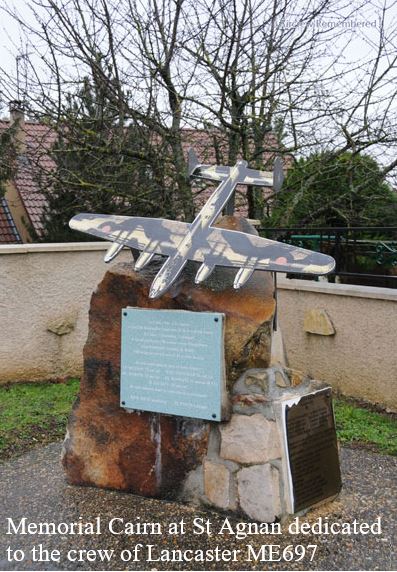
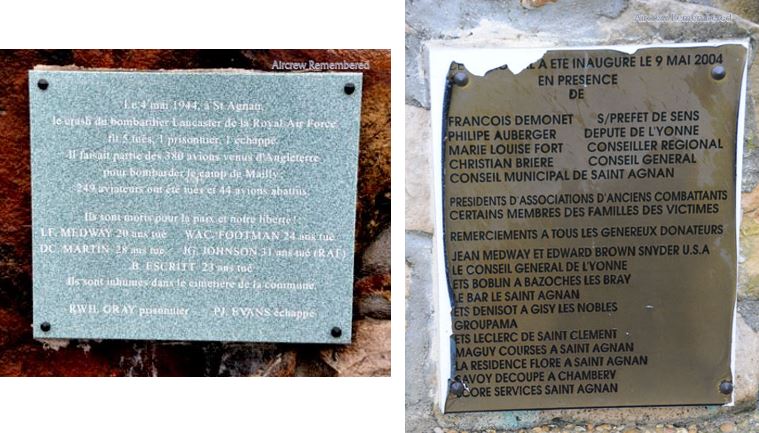
References:
Battle Under the Moon, The documented account of Mailly-le-Camp, 1944: Jack Currie
Nachtjagd War Diaries Volume Two: Theo Boiten and Rod MacKenzie
625 Squadron ORB
CWGC Website
Medway Family Collection
The National Archive Kew
Boys at War, Russell Margerison
Photo Credits:
ME697 Crew: Eileen Edge/ Kevin Ball Collection
F/O L.F. Medway, 60th Commemoration Photos: Medway Family Collection
F/Sgt. Footman: Flying High, Issue 2, April 2008- Night Fight over France
P/O J.G. Johnson: Library and Archives Canada/ancestry.ca, Canada, WW II Service
Files of War Dead, 1939-1947, File 27844, Image 340
S/L Jack Currie, Mailly-le-Camp, LM531 Main Wheel: Battle Under the Moon
Hptm. Helmut Bergmann: Aircrew Remembered Library
Hptm. Martin Drewes: Aircrew Remembered Library
Maps: Jack Albrecht, Roy Wilcock (Aircrew Remembered)
Submission by the Medway family: Barbara Dyer, sister of F/O Leslie Medway, Nick Dyer, nephew, Tina Church, niece and Jeremy Luff, nephew, John Naylor, Jack Albrecht and Nic Lewis
Co-authors:
Maureen Hicks
Reg Price DFC, 625 Squadron Vet.: Re. the 1/3 op edict - 'I can remember that when this was announced at briefing for the night’s operation, which we thought would be our 30th and last Op— the morale in the room was as low as it had been since we joined 625. After a few minutes, the briefing resumed and we were off on our next adventure — the railway yards at Aulnoye, France. We were lucky and returned unharmed, many did not. Our final op was to the city of Lyon, France'. (18 November 2019)
Author’s Note: It is quite remarkable that after all these years that Reg remembers this edict by Bomber Command senior staff as the most demoralizing incident during his tour of ops — akin to the thematic dilemma in the movie: Catch 22.
http://aircrewremembered.com/price-reginald-dfc.ht...
Roy Wilcock - Aircrew Remembered
With thanks to the sources quoted below.
JEA/RW 02.03.2020